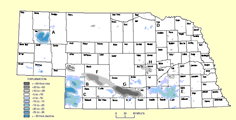Natural Resources, School of
Document Type
Article
Date of this Version
Spring 2020
Citation
Young, A.R., Burbach, M.E., Howard, L.M., Lackey, S.O., Joeckel R.M., 2019, Nebraska Statewide Groundwater-Level Monitoring Report 2019. University of Nebraska-Lincoln, Conservation and Survey Division, Nebraska Water Survey Paper 87, 24 pp.
Abstract
The term “groundwater” has come to be all but synonymous with Nebraska. Nearly three-quarters of the total volume of the High Plains Aquifer lies beneath the State. Groundwater maintains our streams, our ecosystems, our people, and our vitally important agricultural economy. Nebraska’s total groundwater resource is vast, yet it is also vulnerable to natural and anthropogenic changes, necessitating a long-term commitment to wise management through informed decision making. Monitoring, studying, and reporting form the essential basis for such management and, ultimately, for meeting the myriad challenges presented by change.
The personnel of the Conservation and Survey Division (CSD) are proud to support wise groundwater management through the issuance of this report, a yearly continuation of a long-running series of water-resources reports and maps published by CSD. The information provided herein should be used to inform, educate, and guide the citizens of Nebraska regarding water resources. All Nebraskans need clean, abundant and accessible water to sustain our economy and way of life. Therefore, we must all partner in management as informed citizens.
Exceptional flooding dominated water news in Nebraska in 2019. Four-fifths of Nebraska’s counties and scores of cities and towns declared emergencies in response. March 2019 flooding on the Elkhorn, Missouri, Niobrara, and Platte rivers damaged highways, roads, bridges, dikes, and levees. In addition, thousands of homes and hundreds of businesses were damaged, and hundreds of millions of dollars in cattle and crop losses were incurred by Nebraskans. March flooding was projected to cost more than $1.3 billion. Later, in early July 2019, sudden and exceptional rainfall led to historic flooding in central Nebraska on the Platte River and also along the Blue and Wood rivers. By mid-January 2020, Nebraska GovernorPete Ricketts had proposed that almost $60 million in state aid for flood recovery (Schulte, 2020), and Federal Emergency Management Agency funding was continuing to come to Nebraska at the time of the writing of this report in February 2020. The collapse of a tunnel and subsequent washout along the Goshen (Wyoming)/Gering−Fort Laramie Canal, possibly related to soil saturation above the tunnel, disrupted irrigation-water supply to 55,000 acres in Nebraska from July 17 to August 28, 2019.
Included in
Geology Commons, Geomorphology Commons, Hydrology Commons, Paleontology Commons, Sedimentology Commons, Soil Science Commons, Stratigraphy Commons



Comments
WSP-87